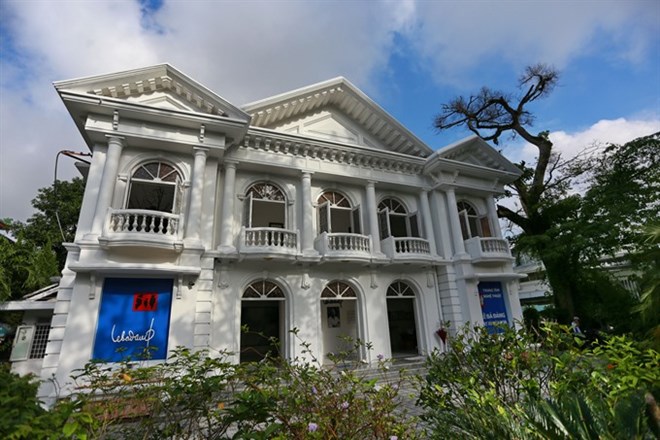
Researchers in the former imperial capital city of Hue have voiced their concerns over the new list of 27 prominent ’Indochinese colonial-style’ architectural buildings in the city.
The building designated for artist Le Ba Dang (Photo: VNA).
According to them, the list includes buildings that are not made in the colonial style while it excludes several buildings built during the French colonial period in the city. The researchers have demanded the elimination of those buildings from the list that have not maintained their status quo due to recent conservation work.
Phu Cam Cathedral, which is included in the list, is said to have a contemporary architectural style. "The cathedral was originally built in the colonial style, but it was knocked down in 1960 to be constructed into a new building, which was completed in 2000. Hence, it cannot be a colonial building,” said researcher Nguyen Xuan Hoa, former director of the local Department of Culture.
He added that the Morin Hotel and Memorial Pavilion for World War Martyrs should also be removed from the list due to changes in their structures and colours.
The original Morin Hotel was built in 1901 with two floors, but later in the 2000s, it was upgraded to four storeys. The Memorial Pavilion was built in 1920, with the inscription bearing the names of 78 Vietnamese and 31 French who had died during World War I. However, conservation work in 2017 destroyed all the inscriptions and changed the colour as well as many architectural patterns on the memorial.
Researcher Tran Dinh Hang, Director of the Vietnam Institute for Culture and Arts Studies in Hue, agreed with Hoa and said the Memorial Pavilion should not be included in the list as it had been changed.
Hoa, meanwhile, questioned why a 100-year-old typical colonial building, located on Le Loi Street, was not included in the list. This building serves as the office of the local Association of Culture and Art. "It is a typical, beautiful building and was the landmark of cultural historical events in Hue,” Hoa said.
The building is listed as one of the targets to be demolished to acquire land for a hotel.
Hang expressed his reservations about the list prepared by the provincial People’s Committee, which said the list was to enhance the conservation of the colonial buildings in the city. Hang said several colonial buildings that were not included in the list were targeted for demolition.
Earlier this month, the provincial People’s Committee had announced a list of 27 prominent Indochinese colonial-style buildings, saying that these buildings will be protected from land revamp for business structures.
Buildings in the list include those built by French colonialists, such as the railway station, Quoc Học School where President Ho Chi Minh used to study, it’s neighbour Hai Ba Trung School and the twin buildings that serve as offices of the Hue Museum of Culture.
Hang said the committee’s efforts to recognise the colonial buildings came late as tens of typical colonial buildings on the streets of Le Loi, Hoang Hoa Tham and Ly Thuong Kiet had already been knocked down to construct new buildings.
According to a study of the Central Region Institute for Constructional Science and Technology, there are some 200 colonial buildings located around Hue. Colonial buildings are part of the architectural history of the city, but few have maintained their original architecture due to changes in the trends of construction.-
Source: VNA
With an increasingly vibrant and widespread emulation movement aimed at building cultured residential areas and cultured families, Yen Thuy District has been making steady progress toward improving both the material and spiritual well-being of its people, while fostering a civilized, prosperous, beautiful, and progressive community.
Once lacking recreational spaces and community facilities, Residential Group 2 in Quynh Lam Ward (Hoa Binh City) has recently received attention for the construction of a new, spacious, and fully equipped cultural house. The project followed the model of state support combined with public contributions in both labor and funding.
The "All people unite to build cultural life" movement, which has been effectively integrated with Kim Boi district’s socio-economic development goals, is fostering a lively spirit of emulation across local residential areas, hamlets, villages, public agencies, and enterprises. In addition, through the initiative, traditional cultural values are being preserved and promoted, while community solidarity and mutual support in poverty reduction and economic development are being strengthened.
A working delegation of the Hoa Binh provincial People’s Committee led by its Permanent Vice Chairman Nguyen Van Toan on June 11 inspected the progress of a project to build the Mo Muong Cultural Heritage Conservation Space linked to tourism services in Hop Phong commune, Cao Phong district.
Born and growing in the heroic land of Muong Dong, Dinh Thi Kieu Dung, a resident in Bo town of Kim Boi district, in her childhood was nurtured by the sweet lullabies of her grandmother and mother. These melodies deeply imprinted on her soul, becoming an inseparable part of her love for her ethnic group's culture. For over 20 years, this love for her hometown has driven Dung to research, collect, and pass down the cultural values of the Muong people to future generations.
In the final days of May, the Ethnic Art Troupe of Hoa Binh Province organized performances to serve the people in remote, mountainous, and particularly disadvantaged areas within the province. These were not just ordinary artistic shows, but they were the meaningful journeys aimed at spreading cultural values, enhancing the spiritual life of the people and contributing to the preservation of ethnic minority cultural identities.


